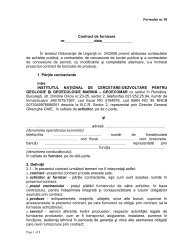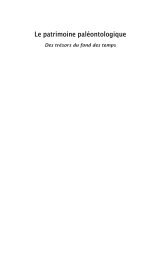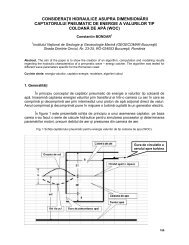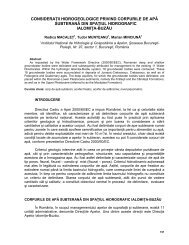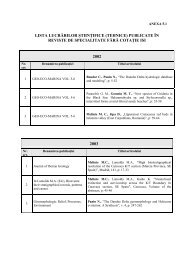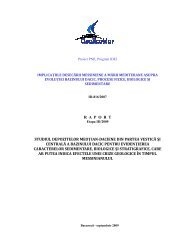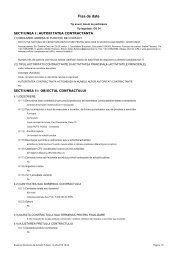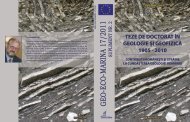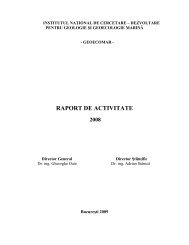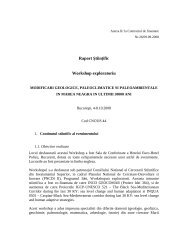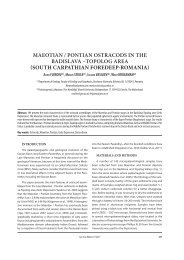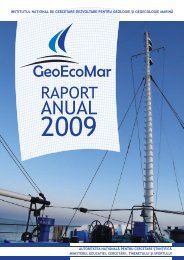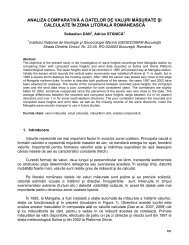THE PALAEOZOIC BRACHIOPODS OF ROMANIA - GeoEcoMar
THE PALAEOZOIC BRACHIOPODS OF ROMANIA - GeoEcoMar
THE PALAEOZOIC BRACHIOPODS OF ROMANIA - GeoEcoMar
Create successful ePaper yourself
Turn your PDF publications into a flip-book with our unique Google optimized e-Paper software.
1e<br />
er<br />
Magdalena lodan - The Palaeozoic brachiopods of Romania<br />
sil<br />
'L,<br />
Iu<br />
I,<br />
<strong>THE</strong> <strong>PALAEOZOIC</strong> <strong>BRACHIOPODS</strong> <strong>OF</strong> <strong>ROMANIA</strong><br />
Magdalena IoRDAN<br />
Geological Institute of Romania, 1 Caransebes St., 78344 Bucharest, Romania<br />
IE<br />
le<br />
t+<br />
rl<br />
ta<br />
ui<br />
3,<br />
ui<br />
r),<br />
ta<br />
ui<br />
l-<br />
of<br />
ts<br />
di<br />
Abstract. The paper describes and reviews the Palaeozoic brachiopods from Carpathians and their foreland (Moldavian, Scythian<br />
and Moesian Platfornrs), incluoing the North Dobrogea orogenic belt. In the South Carpathians the presenc€ of the Lower Silurian<br />
and Lower Carboniferous is attested by brachiopods. The brachiopod assemblage consisting of orthids, strophomenlds,<br />
pentamerids and spiriferids attests the Middle and upper Llandoverian age of the Valea lzvorului Formation. Tha cosmopolitan<br />
faunas suggest that this area correlates with England, Norway (the Oslo region) and Sweden (the Gotland region). The lower<br />
Carboniferous brachiopods includinglant productids and spiriferids attest a Tournaisian age for the Valea ldegului Formation of<br />
the same Danubian domain. The upper calcareous complex of the Moldavian Platform yielded a Silurian shelly fauna facies<br />
consisting mainly of brachiopods. The Wenlockian assemblage is characterized by the appearance of Plectambonitaceatids with<br />
the predominance of leptaenids, lack of protochonetids and nearly complete dissappearence of orthids, The Ludlow-<br />
PridolitGedinnian asesemblage is characterized by the appearance and predominance of protochonetids, appearance of<br />
spiriferids with predominance of delthyrids and by the presence of orthids. The palaeontological assemblage proves the<br />
similarity with Podolian and Baltic faunas, as the Moldavian Platform represents the south-western margin of the East European<br />
Craton. The Romanian part of the Moesian Platform is part of the Protomoesian microcontinent. ln the detrital deposits of the<br />
Cambrian and Ordovician only inarticulate brachiopods were identified (lingulellids and acrotretids), together with middle<br />
Cambrian trilobites, Ordovician graptolites and with palynomorphs. A graptolite shale facies was described in the Silurian, as well<br />
as a shelly fauna facies. Only the mixed type of the graptolite shale facies (Pridolian strata) yielded tiny brachiopods (orbiculoids,<br />
strophomenids, spiriferids) which attest a Rhenish and Bohemian type of faunas. The shelly fauna facies, described only in the<br />
south-western part of the Platform, yieled a neritic shallow water palaeontological assemblage characteristic for Wenlockian,<br />
Ludlowian and Pridolian. In the Devonian time, a rich faunal and floral assemblage was living in the basa! argillitic facies<br />
(Gedinnian-Emsian) and in the middle gritty one (Eifelian), as much as in the upper carbonate-evaporite facies (Givetian.<br />
Famennian). The age inciicator brachiopods (Lower Devonian), as well as the brachiopod zones (Middte and Upper Devonian),<br />
together with the entire palaeontological association attest a similarity with the Rhenish, Moravian, Barrandian and Turkish<br />
Devonran faunas. The Carboniferous brachiopods attest the presence of the Visean (giant productids, strophomonids,<br />
spiriferids) and the Namurian-Westphalian (small productids) and enable correlations with the Dinant and l'{amur from lhe<br />
Western Europe as well as with the East European Platform and Poland. ln the North Dobrogea orogenic belt, {-ower Devonian<br />
brachiopods were identified only in the western part, in the Macin zone, They are associated with crinoids, tentaculites and<br />
suboldinately with trilobites, corals, bryozoans, ostracods and sriggest a very shallow-water deposition in a benthic, open shelf<br />
envtronment, The macrofaunal assemblage correlates with the Ardennes and Rhenish massif (Siegenian), as well as with Poland<br />
and Turkey.<br />
n<br />
Key.words: Brachiopoda, Pall9939g:_lggL9qrpathians,Moldq<br />
ea, Romania<br />
1.INTRODUCTION<br />
2, SOUTH CARPATHIANS<br />
n<br />
l<br />
In Palaeozoic the brachiopods are the most<br />
In the Danubian realm<br />
abundant representative and widespread group of<br />
of the South Carpathians the<br />
presence of the<br />
fossils. In Romania, brachiopods contributed<br />
Lower<br />
for<br />
Silurian and Lower Carboniferous<br />
was attested<br />
attesting of all the stages of the Palaeozoic system.<br />
by brachiopods. In the Godeanu<br />
Mountains, the phyllitic member of the Valea lzvorului<br />
Based on brachiopod assemblages, the presence of the<br />
Formation yielded a rich faunal assemblage<br />
Devonian was attested for the first time in Romania in<br />
dominanted<br />
by brachiopods and trilobites, with<br />
the Bujoarele Hills (North Dobrogea) (Simionescu,<br />
subordinate corals,<br />
crinoids and bryozoans (lordan, Stanoiu, 1993). The<br />
Cadere, 1908; Simionescu, 1924). Other stages of the<br />
fauna appears as lumachellic<br />
Palaeozoic attested on t rachiopods are: the Ludlovian<br />
lenticular interbeds<br />
(coquinas),<br />
in the Moldavian Platform (Macarovici, 1949),<br />
or as isolated specimens,<br />
the Lower<br />
but allways as<br />
moulds or<br />
Carboniferous in<br />
casts. The brachiopod<br />
the South Carpathians (Valea ldegului)<br />
assemblage,<br />
(Codarcea<br />
consisting of Orthids, Strophomenids, Pentamerids<br />
ef a/., 1960) and in the Moesian Platform<br />
and<br />
(Cetate<br />
Spiriferids attest the Middle<br />
borehole,<br />
and Upper Llandoverian age<br />
Patrulius, 1963), as well as all other<br />
(earfy stage of<br />
identifications<br />
the Silurian). They are Dolerofthis<br />
of Palaeozoic starting with 1960 (lordan<br />
sp.,<br />
Mendacella sp., Skenidioides /ew'ssi (Dav.),<br />
1981, 1985). The present paper describes and reviews<br />
Eoplectodonta penkillensis (Reed),<br />
the Palaeozoic brachiopods from the Romanian<br />
Leptaena<br />
rhomboid ali s (Wahl.),<br />
Carpathians and their foreland (Moldavian, Scythian and<br />
Mesoph ol idostrophia sa/opiensis<br />
(Cocks), Strophonella euglypha (Dalm.),<br />
Moesian Platforms,<br />
Coolinia cl.<br />
as well as from the North Dobrogea<br />
aplanata (Salt.), C/onhda globosa (J.<br />
orogenic belt) (Fig. 1).<br />
Sow.), Atrypa<br />
orbicularis J. Sow., Eocoelia hemisphaerica (J. Sow.)<br />
(Plate l). The cosmopolitan<br />
GEO-ECO-MAR|NA,4/1999 135<br />
National lnstitute of Marine Geology and Geo-ecology of Romania<br />
Proc. lntern. Workshop an "Modern and Ancient Sedimentary Environments and Processes" Moeciu, Romania, Oct. I -1 5, 1998
Magdalena lordan - The Palaeozoic brachiopods of Romania<br />
..f- ^{ffi<br />
Apuserri E \V"\u<br />
Mountains<br />
"g ffi#krr"<br />
/ '''r !<br />
{, ,,-J-t"; (}r<br />
\_-.r"o"<br />
U # rr,t,\<br />
\ \I<br />
Mrdirerraneon<br />
\/<br />
a<br />
Jr" ,<br />
plerYonv<br />
BULGARIA<br />
.r''{}^*-''".-'1="\<br />
.r''*'' -)x<br />
i- .--.-.-----n<br />
,i'' ( \<br />
{')\\<br />
/)\<br />
,rr-.-'<br />
ta.rr<br />
'-\<br />
,'<br />
""''r<br />
.{-''',-'( I \<br />
,:'-'-'l \ .) i<br />
'-.-,.r,.<br />
t'l<br />
5i ''tt<br />
';.-a<br />
.,/<br />
ra-:-*_-_-_-.--<br />
----i<br />
.,," / \/^r-a r^Ad,r,,i<br />
Valea Idesului<br />
lTfuu'"u,,uo,u,u'<br />
r'"]r<br />
1o:[<br />
lPeris<br />
Fig. 1. Location maps: a, location of the study area in Europal b, main structural units of the Carpathian foreland in Romania; c,<br />
location of the main boreholes (triangles) and of outcrops (rectangles) with Palaeozoic brachiopods,<br />
faunas suggest that South Carpathians may be<br />
correlated with England (Fronian and Telychian),<br />
Norway and Sweden (Late Rytteraker, Vic and base of<br />
the Bruflat Formations), as well as with USA, Argentina,<br />
Podolia, Siberia. The Lower Carboniferous (sparitic<br />
limestones) was identified by brachiopods including<br />
giant Productids and Spiriferids. In the same Danubian<br />
units, in the Valea ldegului Formation the following<br />
Tournaisian-Visean brachiopods were mentioned<br />
(Codarcea ef a/., '1960): Dictyoclostusemireticulatus<br />
(Mart.), Antiquatonia antiguata (Sow.), Productus<br />
projectus Muir-Wood, Spiifer tomacensis de Kon,, S.<br />
clathratus McCoy, S. sfnfus Mart., S. (Paleochoristites)<br />
cinctus (Kays.), Syingothyis cuspidata Sow., Chonefes<br />
cf. campressa Sibly. This brachiopods assemblage<br />
needs to be reviewed.<br />
136 GEO-ECO-MARINA, 4/1 999<br />
National lnstitute of Maine Geolagy and Geo-ecotogy of Romania<br />
Proc. lntern. Workshop on "Modem and Ancient Sedimentary Environments andProcesses" Moeciu, Romania, Oct. I -15, 1998
Magdalena lordan - The Palaeozoic brachiopods of Romania<br />
3. MOLDAVIAN PLATFORM<br />
4. MOESIAN PLATFORM<br />
In the foreland area of the Romanian East The Moesian Platform is the foreland of the South<br />
Carpathians, the Moldavian Platform corresponds Carpathians and corresponds geographically with lhe<br />
geographically with the Moldavian Plateau and Romanian Plain and the Central and Southern<br />
geologically to the southwestern termination of the East<br />
European Platform. The Sveco-Kareliar'r metamorphic<br />
Dobrogea. This platform is regarded as a Precambrian<br />
block incorporated<br />
the Hercynian European platforms,<br />
basement is overlain by a sedimentary cover with a representing the nucleus of the Protomoesian<br />
lower detrital complex representing the Vendian, microcontinent (Haydoutov, Yanev, 1997). Borehole<br />
Cambrian and Ordovician and an upper calcareous evidence indicates that the basement rocks<br />
complex ascribed to the Silurian+Early Devonian,<br />
Cretaceous, Miocene and Quaternary.<br />
The Silurian is present in a shelly fauna facies<br />
(Neoproterozoic and older metamorphic Formations) are<br />
overlain by a sedimentary cover including Palaeozoic,<br />
Mesozoic and Neozoic deposits.<br />
consisting mainly of brachiopods and subordinately by<br />
Cambrian-Silurian<br />
ostracods, trilobites, gastropods, corals, bivalves,<br />
bryozoans, crinoids and palynomorphs. This<br />
In the detrital deposits of the Cambrian and<br />
palaeonlological assemblage proves the similarity with Ordovician, only inarticulate brachiopods (Lingulellids<br />
Podolian and Baltic faunas. Based on the faunal and Acrotretids) were identified together with Middle<br />
assemblage the Wenlockian, Ludlovian and Pridolian Cambrian trilobites, Ordovician graptolites and with<br />
rock sequences were identified (Macarovici, 1949, 1956,<br />
palynomorphs. In the north-western part of the platform,<br />
1971, 1962, 1965, lordan 1975, 1977, 1982, 1984, the black shales pierced by Mitrofani and Habesti<br />
1 e85).<br />
boreholes yielded Middle Cambrian trilobites associated<br />
with Lingulella feruginea Salt. and the merostomat<br />
The Wenlockian brachiopods identified are:<br />
Hyolites cf . oelandicus Holm. (Mutiu 1988, 1991; lordan<br />
Dolerorthis aff. rustica (Sow.), Isorthis<br />
19901992b,1999a,c).<br />
(Protocortezorthls) sp. ex gr. s/l/ensrs Walm., Ressere//a<br />
aff. elegantula (Dalm.), Leptagonia afl. joachimiana In the eastern part of the platform, the black shales<br />
Havl., L. aff. depressa (Sow.), Dubioleptina expulsa of the Bordei Verde borehole contain the Upper Arenig<br />
(Barr.), Eaplectodonta aff. sowerbiana (Barr.), E. aI{.<br />
(Ordovician) graptolites with the brachiopod Lingulella<br />
transversalis-duvalii (Dav.), Strophonella euglypha aff. davisi McCoy (Murgeanu, Spasov, 1968). ln the<br />
(Dalm.), Coolinia aff studenitze (Wenj.), black shales and tuffaceous grey-greenish mudstones<br />
Strophochonetes cingulafus (Linds.), Antirhynchonella of the Tandarei borehole, minute Acrotretids, Lingulella<br />
cf. linguifera (J.Sow.), Sphaerirhynchia aff. dumanovi<br />
fragments and a Didymograptus fragment were<br />
(Wenj.), Howeilella alf . cuneata (Dalm.), Atrypa<br />
mentioned; together with the palynomorphs, they<br />
orbicularis Sow. (Plate l). The above mentioned species<br />
suggest Tremadoc and Caradoc-Ashgill ages 1O:)<br />
are characteristic for Kitaigorod<br />
(lordan<br />
and Muksha Formations<br />
1972, 1981, 1992b, '1999c; lordan, Spasov,<br />
of the Podolian Wenlockian from the East European<br />
1 e89).<br />
Platform, for the Bardo Beds of the Polish Llandoverian- The Silurian shows a graptolite shale facies,<br />
Wenlockian, for the Liten Formation of Bohemia and for developed mainly in the east and a shelly fauna facies<br />
the Wenlockian from England.<br />
which occurs in the south-western part of the Romanian<br />
Moesian Platform. Only the mixed type of the graptolite<br />
shale facies yielded tiny brachiopods<br />
The Ludlovian brachiopods recorded are lsorthis afl<br />
crassa (Linds.), Leptaena aff. rhomboidalls (Wilck,),<br />
Mesodouvillina costatula (Barr.), Protochonetes<br />
dnlestrensls (Kozl.), P. striatellus (Dalm.), P. ludloviensis<br />
Muir-Wood, Strophochonetes sp., Sphaerirhynchia<br />
wilsoni (Sow.), Atrypa aff. reticularis (Lin.), Delthyris<br />
elevata Dalm., D. magnus (Kozl.) (Plate l). The<br />
macrofauna is characteristic for the Ludlovian of Podolia<br />
and Baltic Sea (Malinovetk and Skala Formations),<br />
Mielnik Beds of Poland. Kopanina Formation from<br />
Bohemia and for the Ludlovian of England.<br />
The Pridolian t Gedinnian was recorded at the upper<br />
part of the pile with calcareous Silurian deposits based<br />
on the following brachiopod species: Protochonetes<br />
dniesfrensLs (Kozl.),' C a m a rotoe c h i a' i nfe I ix Barr., Atry p a<br />
dzvinogrodensis Kozl., Protathyis infantile Kozl.,<br />
Delthyris magnus (Kozl.)(Plate l), characteristic for the<br />
Pridolian (Dzwinogorod Beds) of Podolia; Resserel/a<br />
elegantuloides (Kozl.) characteristic for the Pridolian-<br />
Gedinnian and the species /sorfhis(1.) szajnochai (Kozl.)<br />
and lridistrophia praeumbracula (Kozl.) for the<br />
Gedinrrian Borschov Horizon from Podolia. the<br />
Budnanian of Bohemia and the Downtonian of England.<br />
At the base of the Mangalia borehole (1940-'1942 m<br />
depths), only few brachiopod fragments were found<br />
within the black marly shales which yielded a<br />
palinological assemblage specific for the Wenlockian<br />
(Beju, 1972). In black argillites from the Calarasi<br />
borehole (4970-4500 m depth), tiny brachiopods were<br />
ascribed to generas Plectodonta, Leptostrophia,<br />
Howellella (lordan, 1977 1981; 1984; 1989; 1999c).<br />
These brachiopods, together with graptolites, crinoids,<br />
bivalves, orthoconic nautiloids and ossicles of crinoids,<br />
attest the presence of the Upper Ludlovian. In upper,<br />
Pridolian strata (4400-4500 m) of the same mixed<br />
facies, the following brachiopods are mentioned:<br />
Orbiculoidea sp., Lepfosfrophia sp., Plectodonta sp.,<br />
Howellella sp. (lordan 1981, 1982, '1984,'1985,<br />
1989,<br />
1992b, 1999c). The palaeontologic assemblage attests<br />
Rhenish and Bohemian type of faunas.<br />
In the south-western part of the Moesian Platform a<br />
Silurian shelly fauna was distinguished. Based on the<br />
presence of brachiopods, which are dominant, together<br />
with rare and scarce trilobites, tentaculites, corals,<br />
crinoids, bryozoans, bivalves and ostracods, the<br />
presence of the Wenlockian, Ludlovian and Pridolian<br />
was established in boreholes Girla Mare and Oorisor<br />
/<br />
GEO-ECO-MARINA,4/1999<br />
B7<br />
National lnstitute of Marine Geology and Geo-ecology of Romania<br />
Proc. lntern.Workshopon "ModernandAncientSedimentaryEnvironmentsandProcesses" Moeciu,Romania,Oct.S-15, 1998
Magdalena lodan - The Falaeozoic brachiopods of Romania<br />
PLATE I<br />
Sount CRRpntHnrls<br />
Valea lzvorului Formation, Lower Silurian: Middle and Upper Llandoverian<br />
Fig. 1 * Dolercfthis sp.; Fig. 2 - Eoplectodonta penkillensis (Reed); Fig. 3 - Eocoelia hemisphaerica (J. de C.<br />
Sowerby)<br />
MoTDAVIAN PnrroRn<br />
Bitrinesti borehole, Silurian: Wenlockian<br />
Fig. 4. * Strophonella euglypha (Dalman); Fig. 5 - Leptagoniaff. depressa (Sowerby); Ludlovian: Flg. 6 -<br />
/sodhis aff. crassa (LindstrOm); Fig. 7 - Mesodouvillina costatula (Barande); Fig. 8 - Protochonetes<br />
dniestrensis (Kozlowski); Fig.9 - Delthyris elevata Dalman; Pridolian: Fig. 10 - Delthyris magnus<br />
(Kozlowski)<br />
NoR*r DogRooea<br />
Bujoarele Hills, Lower Devonian: Siegenian-Emsian<br />
Fig. 11 - a) Schizophoia provulvan'a (Maurer); b) Platyorthis circulais (Sowerby); Fig. 12 - Fascistrophedonta<br />
aft. sedgwicki (Arch. et Vern.); Fig. 13 - lridistrophia hipponyx (Schnur); Fig. 14 - Plebejochonetes<br />
plebejus Schnur; Fig. 15 - Acrospirifer pimaevus (Steininger); Fig. 16 - Arduspiifer arduenensis<br />
Iatestriatus (Maurer); Fig. 17 - a) Euryspirifer pellicoi (Arch. et Vern.); b) Hysterclites hysfencus<br />
(Schlotheim); Fig. 18 - Brachyspiifer (8.) carinafus (Schnur); Fig. 19 - Hysterolites hysfencus<br />
Schlotheim, Brachyspirifer (8.) carinatus (Schnur); Fig, 20 - Vandercammenina bischof (Roeme$<br />
Scale bar = 1O mm<br />
138<br />
Proc. lntern<br />
G EO-ECO-MARI NA, 4/1999<br />
National lnstitute of Marine Geology and Geo-ecolagy of Romania<br />
Workshop on "Modern and Ancient Sedimentary Environments and Processes" Moeciu, Romania, Oct. B -15, 1998
Maodalena lordan - The Palaeozoic brachiopods of Romania<br />
PLATE I<br />
..&<br />
tu"<br />
-----*---<br />
V<br />
o<br />
rC<br />
rs<br />
s<br />
s<br />
ffi<br />
G E O -ECO-MARI NA, 4/1999<br />
t39<br />
National lnstitute of Maine Geology and Geo-ecolagy of Romania<br />
Proc.tntern.Workshopon "ModernandAnctentsedimentaryEnvircnmentsandProcesses" Maeciu,Romania,Oct.B'15, 1998
Magdalena lordan - The Palaeozoic brachiopods of Romania<br />
(lordan 1984, 1985; lordan ef a/., 1985; lordan, Spasov, podolica Kozl., Schellwienella umbraculum (Schl.),<br />
1989). In both boreholes the faunal assemblages are of Pletorhyncha cf. speclosa (Hall), Chonetes<br />
neritic and litoral type, sometimes with characters<br />
suggesting shallow water carbonate environment.<br />
(Plebejochonetes) unkelensis Dahm., Eodevonaria<br />
arcuata (Hall), Fimbispirifer daleidensis (Stein.),<br />
Wenlockian brachiopods /sorthrs a'f'f. clivosa Walm., Costi s p i rife r arerosus (Con rd. )., N aj a d o s p i iter n aj ad u m<br />
Morinorhynchus cf . orbignyi (Dav.), Lissostrophia (L.) cf . (Barr.), /sorfhis sp., Sfrophodonta sp., Chonefes sp.,<br />
cooperi Ams., Mesopholidostrophia sp. (Plate ll), Megantheis sp., Camarotoechia sp., Delthyis sp.,<br />
together with long range (Llandoverian-Ludlovian) Uncinulusp. (Plate ll).<br />
Leptaena rhomboidalis (Wahl.) and Atrypa aff . reticularis<br />
The gritty Eifelian is characterized by abundance of<br />
Linn. and with Wenlockian palynomorphs are identified<br />
in the green siltstones of the Girla Mare borehole<br />
(lordan, 1992, 1999). The Ludlovian brachiopods<br />
Fardenia cf . wieniukovi (Kozl.), Howellella cf . bragensis<br />
(Wenj.) and Sfrophodonta sp. were identified in the<br />
Oprisor borehole.<br />
Devonian<br />
In the Romanian part of the Moesian Platform, all the<br />
Devonian stages of the Renish-Ardenne type were<br />
identified. We try to correlate these with the international<br />
standards.<br />
The Lochkovian (Gedinnian), attested in the Oprisor<br />
borehole by the lcriodus woschmidti conodont zone,<br />
contains brachiopod fragments of Strophomenids as<br />
well as Spiriferids, crinoids, corals and orthoceratids.<br />
The Praguian (Siegenian), attested by the<br />
tentacufites zones Nowakia (Turkestanella) acuaria and<br />
Tentaculites straeleni also contains brachiopods,<br />
bivalves, crinoids, corals, gastropods. The following<br />
brachiopods were identified in the Oprisor and Mangalia<br />
boreholes (lordan, 1981, 1985, 1988, '1992b, 1999c):<br />
Orbiculoidea sp , lridistrophia euzona (Fuchs) Chonetes<br />
amaliana de Kon., Delthyris dumontianus (de Kon.), D.<br />
infans Dahmer, Stropheodonta sp., Mutationella<br />
podolica Kozl., Trigonorhynchia daleidensis (Roem.),<br />
Vandercammenina trigeri (Vern.) (Plate ll). Although<br />
diversified, they are on the second place following the<br />
tentaculites, are numerically equal with bivalves and are<br />
more numerous than gastropods, crinoids and corals.<br />
The Zlichovian (Lower Emsian), attested by the<br />
trilobites zones Pseudocryphaeus prostellans, Pilletina<br />
a si at i c a and D i p I e u ra fo rn ix (Mangdia, Calarasi) ( lordan,<br />
1967, 1981, 1985) contains predominantly trilobites and<br />
bivalves and subordinately brachiopods, gastropods,<br />
orthoceratids, corals, crinoids, bryozoans. The following<br />
brachiopods were identified (Raileanu et al., 1966;<br />
fordan, 1981, 1985,'1988): Dignomia hunsruckiana<br />
Fuchs, Levenea cf . subcarinala (Hall), Mutationella<br />
psilophytal plants, placodermi and ostracodermi fishes<br />
and subordinately by brachiopods, tentaculitids,<br />
crinoids, bivalves, gastropods, corals. The following<br />
brachiopods were recorded: Lingulla aff. nuda Hall,<br />
Lingulipora sp., Rhipidomella penelope (Hall),<br />
Leptostrophia rotunda Bubl., Matuitoechia marki Havl.<br />
(Calarasi borehole), Fimbrispirifer sp., /sorfhis sp.,<br />
The Pridolian brachiopods of the tenuis and dayiana<br />
zones are Mesodouvillina subinterstrialis Kozl., Uncinulus sp,, Pholidostrophia sp. (Mangalia borehole),<br />
Eospiifer cf. schmidti Lindstr., Leptostrophia sp., Mediospirifer aff. audacula (Conr.) (Smirna borehole)<br />
Spondilostrophia sp., Shaleia sp., Strophochonefesp. (Plate ll). The presence of the Lingulids beside<br />
(Plate ll), were identified in both Girla Mare and Oprisor eurypterid arthropods, psilophytal plants and placodermi<br />
boreholes.<br />
fishes attest a littoral facies with alternating fresh and<br />
Several criteria enabled to correlate the Silurian sea water sedimentation (shallow shelf environment).<br />
shelly fauna facies of the Moesian and Moldavian<br />
Platforms: the presence of the "shelly fauna facies"<br />
without graptolites; a large number of common elements<br />
in the Chitinozoan assemblage (lasi and Batrinesti<br />
boreholes); the green colour of rocks, which in both<br />
regions is due to detrital chlorite (lordan ef a/., 1985).<br />
'1-he<br />
shelly fauna facies yielded a neritic shallow-water<br />
palaeontological assemblage which shows affinities with<br />
those in Avalonia, Bohemia, Podolia, and Baltic basins<br />
(lordan, 1992b, 1999c).<br />
nalivkini Havl.,<br />
'Spirifef<br />
laevicosta Valenc.,<br />
Schellwienella sp., Iridistrophla sp. (Plate ll).<br />
The Givetian marks the beginning of the carbonateevaporitic<br />
facies in the Moesian Platform. lt is attested<br />
by the following zones: Tentaculites conicus,<br />
Fimbrispirifer yenusfus and Mucrospiifer mucronatus<br />
(lordan 1988, 1999c). The brachiopod assemblage<br />
consists of the species Strophodonta (S.) demissa<br />
(Conr.), Devonochonetes scitulus (Hall), Atrypa<br />
reticularis kuzbasica Rzhon., Mucrospirifer mucronatus<br />
(Conr.), Fimbrispirifer yenuslus (Hall), Punctatrypa<br />
The Frasnian is attested by the zones Homoctenus<br />
krestovnikovi and Mucrospirifer bauchardi. The<br />
brachiopods associated with fragments of crinoids,<br />
gastropods, corals and tentaculites are the following;<br />
Chonetes rowei Cl. et Sw., Athyris aff . vittata Hall., A.<br />
aff. nuculoidea Coop., Mucrospirifer bouchardi (Murch.),<br />
Spinocyrtia martianoffi (Stuck.), Mediospiifer audacula<br />
(Conr.)(Plate ll)(lordan 1981 , 1988, 1999c).<br />
The Famennian is attested by the brachiopods and<br />
conodont zones Cyrtospiifer archiaci and Palmatolepis<br />
crepida. Only the brownish-light grey limestones of the<br />
Viroaga borehole yielded a faunal assemblage<br />
consisting of brachiopods, gastropods, crinoids,<br />
conodonts, forams (moravaminids), holothurian sclerites<br />
and ophiuroids (lordan el al., 1987a; lordan 1985, 1988,<br />
1992b, 1999c). The brachiopod assemblage is<br />
dominated by Spiriferids, whereas Chonetids,<br />
Productids and Rhynchonelids are subordinate. The<br />
following brachiopods were identified: Cyrtospirifer<br />
archiaci (Murch.), C. cf . tchernychevi sibirica lvania, C.<br />
spp., Athyris sp., Productel/a sp., Megachonetes sp.,<br />
Camarotoechr'a sp. (Plate ll),<br />
Carboniferous<br />
All the stages of the Carboniferous system have<br />
been attested on the base of zones and age indicator<br />
fossils like gastropods, orthoceratids, fenestelides,<br />
corals, crinoids, plant debris, fish scales (lordan ef a/.,<br />
1987b; lordan 1985, 1992a, 1999a,c).<br />
The Visean is attested by the conodont zone<br />
Ligonodina fragilis and the brachiopods Schizophoria<br />
resupinata gigantea Dem., Gigantoproductus giganteus<br />
GEO-ECO-MARINA,4/1999<br />
t40<br />
National lnstitute of Marine Geology and Geo-ecology of Romania<br />
Proc. Intern. Workshop on "Modern and Ancient Sedimentary Environments and Processes" Moeciu, Romania, Oct. B -15, 1998
Magdalena lordan - The Palaeozoic brachiopads of Romania<br />
(J.Sow.), G. bisati Paeck., Echinochonchus defensus<br />
(Thom.), Dictyoclostus cf. multispiniferus (Muir-Wood),<br />
D. semireticulatus (Martin), Daviesiella sp. cf. D.<br />
llangollensis (Dav.), Antiquatonia antiquata (Sow.),<br />
Linoprotonia corrugato-hemisphaeica (Flem.), Reticulariina<br />
cf . splnosa (Nor., Prat.), Megachonetes ex. gr. M.<br />
zimmermani (Paeck.), Schellwienella sp., Schuchertella<br />
sp., Chon'sfifesp., 'Lingula'sp. (Plate ll) (lordan ef a/.,<br />
1985,1987b).<br />
The Namur-Westphalian in the paralic facies with<br />
coals, carbons and plant debris is attested by a<br />
palaeontological assemblage consisting of bivalves,<br />
brachiopods, goniatites, orthoceratids, crinoids,<br />
holothurian sclerites, forams. The brachiopods identified<br />
so far include: Lingula mytiloides Sow., Orbiculoidea<br />
mrssoun'ensis (Schum.), Schizophoria sp., Chor'sfl/es<br />
mosquensis Fisher, Productus carbonarius de Kon.,<br />
Dictyoclostus retiformis Muir-Wood, D. semireticulatus<br />
hermosanus Girly, Semrplanus cf. /afi'sslmus Sow. (Plate<br />
ll) (lordan 1985, 1992a, 1999a, c; lordan et a|.1987b).<br />
Carboniferous faunal palaeontological assemblages<br />
and lithological features of the Moesian Platform are of<br />
West-European type (England, France, Belgium,<br />
Dinant-Namur basins), of Poland and Bulgaria, as well<br />
as of East-European type. This suggests that during the<br />
Carboniferous the Moesian Platform has worked like a<br />
transitional bionomical zone (lordan, 1985, 1992a,<br />
1999a, c).<br />
The brachiopod assemblages of the Visean consist<br />
largely of giant Productids and subordinately<br />
Strophomenids, Spiriferids, Orthids and Inarticulates;<br />
small Productids with some Strophomenids and<br />
Inarticulates characterize the Namurian-Westnhalian of<br />
the Moesian Platform.<br />
5. NORTH DOBROGEA<br />
In the Eoalpine North Dobrogea orogenic belt, the<br />
Palaeozoic shows shallow marine (detrital and<br />
calcareous) facies in the western Macin zone, and a<br />
deep water facies (siliceous pelagites and distal<br />
turbidites) in the northern part of the eastern Tulcea<br />
zone.<br />
Lower Devonian brachiopods were identified only in<br />
the Macin zone, in the Bujorul Rom6nesc and Bujorul<br />
Bulgaresc hills. They are associated with crinoids and<br />
tentaculites and subordinately with trilobites, corals,<br />
bryozoans and ostracods. This macrofaunal<br />
assemblage attests an open marine shelf, a benthic<br />
environment with a very shallow-water deposition. Both<br />
the lithological characters and the fossil content<br />
correlates with the Ardennes and the Rhenish massif<br />
(Siegenian), as well as with Poland and Turkey<br />
(Bithynia-Bosphorous) (Haas, 1968; Jahnke, 1971:<br />
lordan, 1974, 1985, 1988, 1999 a, b; Carls et a1.,1982;<br />
Becker, Jansen, 1998; Jansen, 1998).<br />
The Brachiopods are represented by Schizophoia<br />
provulvaria (Maur.), Platyorlhis circularis (Sow.),<br />
Dalmanella fascicularis (d'Orb.),'Orthis' sfngosa Sow.,<br />
Leptaena sp ex gr. rhomboidalis (Wilck.), Phoirnaranjoana<br />
(Vern.), Rhenostrophia<br />
dostrophia aff.<br />
subarachnoidea (Arch, et Vern.), Fascistropheodanta<br />
aff . sedgwicki (Arch. et Vern.), Leptostrophiella sp. ex<br />
gr. explanata (Sow.), Douvillina interstrialis (Phill.),<br />
I ridostrophi a hi pponyx (Schnur), Chanetes sarcinul atu s<br />
(Schl.), Plebejochonetes. plebejus Schnur, Reflchonefes<br />
aff. minutus (Buch), Straphochonefes tenulcosfafus<br />
(Oehlert), Acrospirifer primaevus (Stein.), Euryspirifer<br />
pellicoi (Arch. et Vern,), Hysterolites hystericus (Schl.),<br />
Arduspirifer arduennensis latestriatus (Maur.),<br />
Brachyspirifer (8.) carinatus (Schnur), Vandercammenina<br />
bischofi (Giebel), 'Spirifef cf. undulifer Kayser,<br />
Uncinulus cf . antiquus (Schnur), Camarotoechia sp ,<br />
Meganteris cf . archiaci(Vern.) (Plate l).<br />
The brachiopod assemblage is dominated by<br />
Strophomenids and Spiriferids, whereas Orthids,<br />
Rhynchonelids and Terebratulids are subordinate and<br />
even very scarce. The brachiopods compose 1-2 cm<br />
thick coquina layers, forrned mainly by disarticulate<br />
valves, sometimes brocken and with the convexity high<br />
up. These features suggest that after disarticulation<br />
coquinas were transported by waves and deposited on a<br />
beach of a quiet bay. Compared to the widespread<br />
Devonian facies of the world, our data attest the mixed<br />
facies of the Devonian (Simionescu, 1924;<br />
Paeckelmann, 1935; lordan, 1974,<br />
'1988).<br />
6. CONCLUSTONS<br />
In the Cambrian and Ordovician deposits from<br />
Romania only inarticulate brachiopods (Lingulellids and<br />
Acrotretids) were identified.<br />
In Silurian formations the brachiopods are very<br />
diversified: a) they are tiny and scarce in the mixed<br />
shale facies (Upper Ludlovian, Pridolian) in the eastern<br />
Moesian Platform; b) and very abundant and diversified<br />
in the shelly fauna facies of the western Moesian<br />
Platform, of the Moldavian Platform and of the South<br />
Carpathians Danubian units.<br />
In the Devonian time the brachiopod assemblage is<br />
very rich and diversified. They have given age indicators<br />
for the Lower Devonian of the Moesian Platform and<br />
North Dobrogea orogenic belt, as well as brachiopod<br />
zones for the Middle and Uoper Devonian of the<br />
Moesian Platform.<br />
In the Carboniferous rocks the brachiooods are<br />
restricted to giant Productids, Strophomenids and<br />
Spiriferids in its lower part in the South Carpathians and<br />
the Moesian Platform and to small Productids in its<br />
upper part in the Moesian Platform.<br />
No macrofauna was identified so far in the Permian<br />
strata of Romania.<br />
REFERENCES<br />
BECKER, G., JANSEN, U., 1998, Solle's "Hunsriick-lnsel": Ein<br />
KUstennahe Fauna (Ostracoden, Brachiopoden, Trilobiten)<br />
aus Rotsedimenten des Ober-Emsium (Unterdevon) der<br />
Moselmulde (Linksrheinisches Schiefergebirge).<br />
Senckenbergiana lethaea, 77, 112, 195-221 , Frankfurt am<br />
Main.<br />
BEJru, D., 1972, Zonare gi corelare a Paleozoicului din<br />
Plaiforma Moesica pe baza asociatiilor palinoprotistologice.<br />
Part. l. Rev. Petrol gi Gaze, 23112, Bucuresti.<br />
CARts, P,, JAHNKE, H., LUSZNAI, M,, RACHEBoEUF, P., 1982,<br />
On the Siegenian siage. Cour. Forsch. Inst. Senckenberg,<br />
55. 181-198, Frankfurt am Main 1.8.<br />
GEO-ECO-MAR|NA,4/1999<br />
Al<br />
National lnstitute of Maine Geology and Gea-ecology of Romania<br />
Proc. lntern. Workshop on "Modern and Ancient Sedimentary Environments and Processes" Moeciu, Romania, Oct. I -15, 1998
Magdalena lordan - The Palaeozoic brachtopods of Romania<br />
PLATE II<br />
Moesnn PLATFoRM<br />
Silurian: Wenlockian. Fig. 1 - Lissosfrophia cooperi Amsden, /sorfhys aff. clivosa Walmsley, Girla Mare<br />
borehole. Pridolian. Fig.2 - Eospirifer d, schmidti Lindstr6m (GArla Mare borehole); Devonian, Pragian: Fig. 3<br />
- Mutationella podolica Kozlowski (Oprisor borehole); Mangalia borehole: Fig. 4 - Iidistrophia euzona<br />
(Fuchs); Fig. 5 - Chonetes ornaliana de Koninck; Fig. 6 - Trigonorhynchia daleidensis (Roemefl; Fig. 7 -<br />
Delthyris dumontianus (de Koninck); Zlichovian: Fig. I - Levenea cl. subcarinata (Hall); Fig. 9 - Schellwienella<br />
umbraculum (Schlotheim); Fig. 10 - Fimbrispirifer daleidensis (Steininge|; Fig. 11 - Costispiifer arenosus<br />
(Conrad); C6lirasi borehote; Eifelian: Fig, 12 - Leptostrophia rotunda Bublicenko (CilSrasi borehole)i Fig. 13<br />
- Mediospirifer audacula (Conrad), a) brachial valve, b) pedicle valve; Givetian: Fig. 14 - Mucrospiifer<br />
mucronatus (Conrad); Fig. 15 - Fimbispirifer aff. venustus (Hall) a, b; Fig. 16 - Sfrophodonta (5.) demissa<br />
(Conrad)(G6rla Mare borehole); Frasnian: Fig. 17 - Athyris aff. viftata Hall; Fig. 18 - Mucrospiifer cf.<br />
bouchardi(Murchison); Fig. 19 - Spinacyftia martianoffi (Stuckenberg); Famennian: (Viroaga borehole) Fig. 20<br />
- Cyrtospirifer archiaci (Murchison); Fig. 21 - Cyrtospiifer tchemychevi sibirica lvania; Carbonifer: Visean<br />
(Dobromiru borehole); Fig. 22 - Gigantoproductus giganteus (J, Sowerby); Fig. 23 - Dictyoclosfus<br />
semireticulatus (Martin); F3g. 24 - Reticulariina cf, spinosa (Nor. et Prat); Namurian-Westphalian: Fig. 25 -<br />
Dictyoclostus retiformis Muir-Wood; Fig. 25 - Productus carbonarius de Koninck; Fig. 27 Chonsfites<br />
mosguensrs Fisher.<br />
Scale bar = 1O mm<br />
National lnstitute of Maine Geology and Geo-ecology of Romania<br />
Proc. lntern. Workshop on "Modern and Ancient Sedimentary Environments and Processes" Moeciu, Romania, Oct. I -15, 1998
----<br />
Magdalena lordan - The Palaeozoic brachiopods of Ramania<br />
PLATE II<br />
4<br />
13a 13b<br />
.,6'''.<br />
W;,<br />
:.:<br />
i, :<br />
vs,<br />
17a r7b<br />
ffi<br />
V<br />
20<br />
W<br />
ffi',<br />
17d<br />
25<br />
t I<br />
G EO-ECO-MARI N A, 4/1999 143<br />
Natpnal lnstitute of Marine Geology and Geo-ecology of Romania<br />
Prac. lntern. Workshop on "Modern and Ancient Sedimentary Environments and Processes" Moeciu, Romanla, Oct. I -15, 1998
Magdalena lordan - The Palaeozoic brachiopods of Romania<br />
CoDARCEA, A,, RATLEANU, G., NAsrAsrnruu, S., 1960, Carboniferui<br />
inferlor de pe Valea ldegului (virsta calcarelor de ldeg). St.<br />
cerc. geol., geol.-geogr., V, 3, 407-418.<br />
HAAS, W., 1968, Das Alt-Palaeozoicum von Bithynien<br />
(Nordwest- Turkei). N. Jb, Geol. Paleont. Abh., 13112,<br />
Stuttgatt.<br />
HAyDourov, 1., YANEV, S., 1997, The Protomoesian<br />
microcontinent of the Balkan Peninsula * a peri-Gondwana<br />
piece. Tectonophysics 272, 303-313.<br />
loRDAN, M., 1967, Consideratii asupra Paleozoicului inferior de<br />
la Mangalia pe baza studiului Trilobitilor gi Tentaculitilor<br />
(Platf. MoesicS). D. S. Com Geol. Lltl/1,339-385.<br />
lORDAN, M,, 1972, Graptolitii din forajul Jbndbrei (Platf.<br />
Moesicd). D. S. Inst. Geol. LVllU3, 31-47.<br />
ioRDAN, M., 1974, Studiul faunei Devonian inferioare din<br />
Dealurile Bujoare (Unitatea de Micin, Dobrogea de Nord).<br />
D. 5. Inst. Geol., LX/3, 33-78.<br />
loRDAN, M., L975, Studiul biostratigrafic al Paleozoicului din<br />
foralul Bdtdnegti (Platforma Moldoveneasca). D, S. Inst.<br />
Geoi , LXI/4, 27-50.<br />
loRDAN, M., L977, Consideratii asupra Pridolianului in Rom6nia.<br />
Comunicdri, Sect. Geologie. Univ. Buc, 135-142.<br />
loRDAN, M., 1981, Study of Silurian and Devonian faunas from<br />
the Eastern part of the Moesiarr Platform. Mem. lnst. Geol.<br />
Geofiz., 30, 115-222 (thesis presented on 16 April 1977,<br />
Iasi).<br />
loRDAN, M., 1982, Biostratigrafia Silurianului din forlandul<br />
Carpatilor Romdnegti. Lucr. Ses. St. Gr. CobElcescu, Ia5i,<br />
1981., 191-198.<br />
loRDAN, M., 1984, Biostratigraphy of the Silurian and Devonian<br />
in the Moldavian and Moesian Platforms (RomAnia). An.<br />
lnst. Geoi. Geofiz., LXIV, 259-267.<br />
loRDAN, lvl., 1985, Brachiopode Paleozoice in RomAnia, Lucr.<br />
Ses. St. Gr. Cobdlcescu, Univ. Al. l. Cuza, Iagi, 113-125.<br />
loRDAN, M., 1988, Biostratigraphy of the Devonian in Romania.<br />
ln: Devonian of the World. Proc, 2-nd lntern. Synrp. Devon<br />
System, Calgary - 1987, Canada. Canadian Soc. of<br />
Petroleum Geologists, 14, 'l , Calgary, 5A7-512.<br />
loRDAN, M., 1990, Biostratigraphic guide marks in the Lower<br />
Paleozoic strata of the Moesian Platform, Romania.<br />
Abstracts. IGCP Programme, Projects 216 & 303 - Global<br />
Biological Events Precambrian-Cambrian Event<br />
Stratigraphy, Oxford, Sept. 1990.<br />
loRDAN, M., 1992a, Biostratigraphy of the Upper Palaeozoic<br />
successions of the Moesian Platform of Romania. Final<br />
tsio-Event Conf., Abstracts, Gottingen,1992.<br />
loRDAN, M., 1992b, Biostratigraphic age indicators in the Lower<br />
Paleozoic successions of the Moesian Platform of<br />
Romania. Geologica Carpathica, 43, 4, 231-233.<br />
loRDAN, M., 1999a, Biostratigraphy of the Paleozoic from the<br />
ioreland of the Romanian Carpathians. Abstracts volume<br />
of the Joint Meeting of EUROPROBE TESZ, PANCARDI<br />
and Georift Projects "Dobrogea- the interface between the<br />
Carpathians and the Trans-Eui'opean Suture Zone", Tulcea,<br />
1999; Rom. J. Tect. Reg. Geol., 77, suppl. 1, 59-60"<br />
loRDAN, M., 199Sb, Biostratigraphy of the Paleozoic ln North<br />
Dobrogea. Excursion Guide of the Joint Meeting of<br />
Europrobe Tesz, Pancardi And Georift Projects 'Dobrogea<br />
- The lnterface Between the Carpathians and the Trans-<br />
European Suture Zone', Tulcea, 1999: Geology and<br />
structure of the precambrian and paleozoic basement of<br />
North and Central Dobrogea, Mesozoic history of north and<br />
central dobrogea. Rom. J. Tect. Reg. Geol., 77, suppl. 2,<br />
23-24.<br />
loRDAN, M., 1999c, Biostratigraphy of the Paleozoic in the<br />
Moesian Platform. Excursion Guide of the Joint Meetino of<br />
EUROPROBE TESZ, PANCARDI and Georift Projects<br />
"Dobrogea- the interface between the Carpathians and the<br />
Trans-European Suture Zone", Tulcea, 1999: Geology and<br />
structure of the Precambrian and Paleozoic basemeni of<br />
North and Central Dobrogea. Mesozoic history of North and<br />
Central Dobrogea. Rom. J. Tect. Reg. Geol., 77, suppl. 2,<br />
18-23.<br />
loRDAN, M, SpAsoV, H., 1989, Lower Paleozoic (Cambrian-<br />
Silurian) sediments of the Moesian Platform. XIV Congress<br />
CBGA, Sofia, 1989, Abstracts, 702-705.<br />
loRoAN, M., Sriruoru, 1., 1993, On the Lower Siturian<br />
macrofauna (Llandoverian) from the Valea lzvorului<br />
Formation (South Carpathians). Rev. Roum. Geologie, 37,<br />
63-76.<br />
IORDAN, M., ILIESCU, V., VISARIoN, A., BALTRFS, A., SAruouIrscu,<br />
E., SETFERT, K., 1985, Litho- and biostratigraphy of the<br />
Paleozoic sequences in the Oprigor and Garla Mare<br />
boreholes (South-western pad of the Moesian Platform). D.<br />
S. Inst. Geol Geofiz., LXIX/4, 5-28.<br />
IORDAN, M., MIIR,4U]A, E,, ANToNEScU, E., IVA, M.,<br />
GHEoRGHTAN, D., 1987a, The Devonian and Jurassic<br />
Forrnations in the Viroaga borehole - South Dobrogea<br />
(South-Eastern part of the Moesian Platform). D. S. Inst,<br />
Geol. Geofiz., 72-7314, 5-18.<br />
IoRDAN, M., ToMESCU, C., ANToNESoU, E,, ILIESCU, V., IVA, M.,<br />
BiTorANU, C., VA|DA, M., '1987b, Formations Jurassiques et<br />
Pal6ozoiques sup6rieurs du forage Dobromiru - Dobrogea<br />
de Sud (SE de la Plateforme Moesienne). D. S. Inst. Geoi.<br />
Geofiz., 72-7314, 19-44.<br />
JAHNKE, H., 1571, Fauna und Alter der Erbslochgrauwacke.<br />
GottingerArb. Geol. Palaeont., 9, 105 p., Gottingen.<br />
JANSEN, U., 1998, Anmerkungen zur Devon-Korrelationstabelle,<br />
Brzadi9S: Strophomenida, Rheinisches Schiefergebirge,<br />
Senckenberglana lethaea, 78, 112, 229-233, f:rankfurt am<br />
Main.<br />
MAcARovrcr, N., 1949, Observatii asupra sondajului de la<br />
Deleni. Rev. St. V. Adamachi. 35. lasi.<br />
MAcARovrcr, N., 1956, Asupra faunei Silurianului din<br />
fundamentul Podisului Moldovenesc. An. St. Univ. lasi. sect<br />
ll, St. Nat l. 1. lasi.<br />
MAcARovrcr, N., 1971, La faune silurienne du fundament du<br />
Plateau moldave (les forages de lassy et de Todireni-<br />
Botosani). An. St. Univ. Al.l, Cuza, sect biol., geol., XVll,<br />
lasr.<br />
MACARovrct, N., BEJU, D., OLARU, L., 1965, Date noi asupra<br />
faunei Silurianului din fundamentul Podigului Moldovenesc.<br />
An. St. Univ. Al. l. Cuza, lasi, sect. ll, St. Nat., b, Geol.-<br />
Geogr., Xl.<br />
MAcARovrcr, N., PAGHTDA, N., 1962, Observatii stratigrafice<br />
asupra sondajului de la Todireni (Raionul Boto$ani). An. S1.<br />
Univ. Al. L Cuza, Iagi, sect. ll, St. Nat., b, Geol.-Geogr.,<br />
vilt.<br />
MURGEANLJ, G., SpAsov, H., 1968, Les graptolites au foraj<br />
Bordei Verde (Roumanie). Bull. Geol. Inst. ser Paleont.,<br />
XVll, 229-238, Sofia.<br />
MuTtu, R., 1988, Asupra prezentei Cambrianului mediu in<br />
Rom8nia. Rev. Mine, Petrol, Gaze, Bucuregti.<br />
MUTIU, R., 1991, On the presence of Cambrian in the Moesian<br />
Platform (Romania). Rev. Roum. Geol., 35, 75-85.<br />
PAECKELMANN, W., 1935, Probleme der Varistikums der<br />
Dobrudscha. Z. d. geol. Ges., 87, 1, 507-522, Berlin<br />
PATRULTUS, D., 1963, Studiul stratigrafic al depozitelor<br />
mesozoice 9i paleozoice traversate de forajul de la Cetate<br />
(partea de W a Cdmpiei Rom6ne). D. S, Com. Geol., 69, 1.<br />
144 G EO-ECO-MARI NA, 4/1 999<br />
National lnstitute of Marine Geology and Geo-ecology of Romania<br />
Proc. lrttern. Workshop on "Modern and Ancient Sedlmentary Enviranments and Processes" Moeciu, Romania, Oct. B -15, 1998
Maqdalena lordan - The Palaeozoic brachiopoCs of Romania<br />
PATRULTUS, D., loRDAN, M., MTRAUTA, E.. 1967, Devonian of SrMroNEScu, 1., CAoenr, D., 1908, Nota preliminarb asupra<br />
Romanra, Intern. Symp. on the Devonian, Sept 1967, straturilor fosilifere devonice din Dobrogea An. Inst. Geol<br />
Calgary, Canada, 127-134.<br />
Rom., l/3.<br />
RArr-Enruu, G., lononr.r, M., Aur\,lEHivET DANET, N., BEJU, D, STMTONESCU, 1., 1924, Fauna devonici din Dobrogea. Mem.<br />
1966, Studiul Devonianului din forajul Ce la Mangalia. D. S. Sect. St. An. Acad. Rom., lll/ll/'l .<br />
Com. Geol.. LlUl . 323-339,<br />
GEO-ECO-MAR|NA,4/1999<br />
rus<br />
llational lnstitute of Marine Geology and Geo-ecology of Romania<br />
Proc. lntern.Workshopon "ModernandAnctentSedintentaryEnvironmentsandProcesses" Moeciu,Romania,Oct.S-15, 1998



